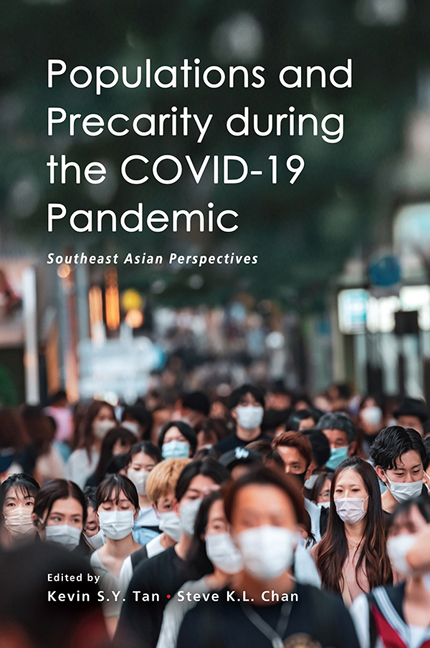Book contents
- Frontmatter
- Contents
- Preface
- About the Contributors
- 1 Introduction: Populations, Precarity and the COVID-19 Pandemic
- 2 Transformation of the Family Structure in Southeast Asia: Trends and Implications
- 3 New Normal, Old Ties: COVID-19’s Social Impact on the Singapore-Johor Bahru Connection
- 4 Unequal Flows: Examining the Factors Surrounding Thai and Vietnamese Labour Migration to South Korea
- 5 Emplacing Multiculturalism: Southeast Asian Migrant Linguistic Acculturation Programmes and Community Building in South Korea
- 6 “Foreign Talent” in Singapore and Some Implications for Schools
- 7 Managing Disaster Risk and Enabling Social Protection in Thailand: Some Lessons from the COVID-19 Pandemic
- 8 Transnational Housing Insecurity: Mobility, Homelessness, and the COVID-19 Pandemic
- 9 Older Persons with Hearing Disabilities in Indonesia: Vulnerability and Demographic Diversity during the COVID-19 Pandemic
- Index
3 - New Normal, Old Ties: COVID-19’s Social Impact on the Singapore-Johor Bahru Connection
Published online by Cambridge University Press: 01 March 2024
- Frontmatter
- Contents
- Preface
- About the Contributors
- 1 Introduction: Populations, Precarity and the COVID-19 Pandemic
- 2 Transformation of the Family Structure in Southeast Asia: Trends and Implications
- 3 New Normal, Old Ties: COVID-19’s Social Impact on the Singapore-Johor Bahru Connection
- 4 Unequal Flows: Examining the Factors Surrounding Thai and Vietnamese Labour Migration to South Korea
- 5 Emplacing Multiculturalism: Southeast Asian Migrant Linguistic Acculturation Programmes and Community Building in South Korea
- 6 “Foreign Talent” in Singapore and Some Implications for Schools
- 7 Managing Disaster Risk and Enabling Social Protection in Thailand: Some Lessons from the COVID-19 Pandemic
- 8 Transnational Housing Insecurity: Mobility, Homelessness, and the COVID-19 Pandemic
- 9 Older Persons with Hearing Disabilities in Indonesia: Vulnerability and Demographic Diversity during the COVID-19 Pandemic
- Index
Summary
Old Neighbours
Singaporeans and Malaysians share a common social-cultural and political past. In fact, the origins of their respective sovereignties are highly entwined with each other (Baker 2014; Shiraishi 2008). This is because from 1963, the two countries were part of the same nation for almost two years. However, due to increasing political differences and ethnic tensions, Singapore was accorded an independence from 1965 that was never entirely planned nor self-determined. Nevertheless, in spite of political separation, the ties that have bounded their citizens have continued in the areas of economy, culture and even sports (Little 2013, pp. 635–51). A tangible testimony to such ties is best revealed when one observes the porous nature of the borderlands connection (Chan and Womack 2016, pp. 95–103) between the two countries, where continuing flows of labour, income and resources have contributed to the subsequent growth and development of Singapore and Johor Bahru (Hampton 2010, pp. 239–53; Hutchinson and Rahman 2020), the closest Malaysian city to Singapore. Rather than existing simply as a boundary, the border checkpoints and the lands adjacent to them express varying levels of liminality (Kurki 2014, p. 1061). An essential component that has enabled this is the existence of two causeways, or bridges, which connect Singapore's much smaller island-state to the rest of the peninsula occupied by its larger neighbour, Malaysia.
These two causeways connect Singapore to the southern tip of Peninsula Malaysia via Johor Bahru across the Straits of Johor. They enable travel over a body of water that stretches from 1.5 kilometres to 4.8 kilometres at this widest point. While both causeways serve similar functions, they vary in terms of their relative age. The far older Woodlands Causeway first became accessible for cross-straits traffic on 1 October 1923, but was only officially opened the following year on 11 June 1924 after full completion (Chua 2009). Even till present times, it has been referred to as “The Causeway” or the “Woodlands Causeway” by locals on both sides of the border. The second and comparatively newer bridge, is better known as the “Tuas Second Link” and it officially began operating on 18 April 1998 as part of efforts to lessen the burgeoning human traffic at the older Woodlands Causeway (Lim Tin Seng 2020).
- Type
- Chapter
- Information
- Populations and Precarity during the COVID-19 PandemicSoutheast Asian Perspectives, pp. 28 - 49Publisher: ISEAS–Yusof Ishak InstitutePrint publication year: 2023



